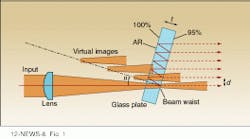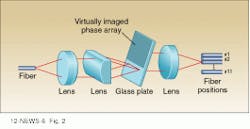OPTOELECTRONIC COMPONENTS: Virtual imaging array splits light into ten wavelengths
Researchers at Fujitsu Laboratories Ltd. (Atsugi, Japan) have developed a virtually imaged phase array (VIPA) for simultaneously splitting light into multiple wavelengths. A VIPA offers angular dispersion 10 to 20 times larger than existing optical methods and lower polarization dependence.
For optical multiplexer/demultiplexers in high-density wavelength-division-multiplexing (WDM) systems, current methods for simultaneously splitting light into multiple wavelengths are either based on a diffraction grating or a phase array. The diffraction-grating technique has several disadvantages. These include a small angular dispersion and a long optical path within the multiplexer/ demultiplexer, which makes transmission characteristics sensitive to misalignment of the optical elements, and polarization-state dependence of the diffraction efficiency, which causes polarization-dependent loss in the multiplexer/demultiplexer.
The alternative phase-array waveguide device also has drawbacks, however. These include the need to eliminate the phase error of the light transmitted through each waveguide and suppression of the deviation of the waveguide parameters over the entire substrate, which requires accurate control of waveguide parameters such as size, refractive index, and temperature.
The Fujitsu VIPA was described by senior researcher Masataka Shirasaki at the Micro-optics Conference sponsored by the Japan Society of Applied Physics (Hiroshima, Japan; October 1995). The component is made from a 100-µm-thick plate of glass and a semi-cylindrical lens. One side of the glass is coated with a high-reflectivity film (95% reflectivity), the other side with 100% reflectivity film except for the window area, which is antireflection coated.
Input light enters the plate and is focused on the other side of the plate with a lens; 5% of the light passes through the surface and diverges after the beam waist, and 95% of the input light hits the same surface and is displaced by the distance d after two reflections (see Fig. 1). The beam shape in each path is formed so that the light diverges from the virtual image of the beam waist. These virtual images are located along a line that is normal to the plate with a constant spacing of 2t (where t is the thickness of the plate). All the beams then interfere and form collimated light, where the light propagates in the direction determined by the Bragg angle (apart from widening the angular dispersion and eliminating the effect of the phase error).
Cost advantages
According to Shirasaki, the VIPA is smaller and lower cost than a phase-array waveguide. The 100-µm thickness of the glass plate means that 100 or more chips can be made from one wafer; for a phase-array device, each waveguide is about 1 × 1 in., so only five or six pieces can be made from a wafer. Unlike a diffraction grating, where the grating pitch must be made uniform, in the VIPA the positions of the beam waists are self-aligned, and individual positions do not need to be adjusted.In a demultiplexing experiment, the researchers used 1550-nm light from a tunable diode laser, which was focused through the window area (see Fig. 2). The output angle was very sensitive to changes in the wavelength; and the angular dispersion varied from 0.4 to 0.8 /nm, which is 10 to 20 times larger than for WDM components based on conventional diffraction gratings. Using this angular dispersion, ten wavelengths in the 1540- to 1560-nm range were demultiplexed with a 0.8-nm spacing, and the polarization-state dependence at the peak wavelength was confirmed at 0.1 dB.
According to Shirasaki, Fujitsu Laboratories is considering ways to produce the VIPA and is searching for better technology to position the fiber array or photodiode array. The company has no plans to market the component.

